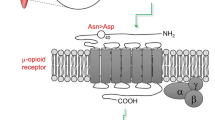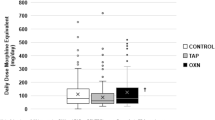Abstract
Morphine is the analgesic of choice for moderate to severe cancer pain; however, 10–30% of patients do not tolerate morphine. This study evaluated genetic variation in the μ-opioid receptor, βarrestin2, stat6 and uridine diphosphate-glucuronysltransferase 2B7 (UGT2B7) genes, in patients who responded to morphine vs those who were switched to alternative opioids. We prospectively recruited and genotyped 162 Caucasian patients (117 controls, 39 switchers). Switchers, were more likely to carry the common allele at 1182 G/A, 5864 G/A, 8622T/C and 11143 G/A in the βarrestin2 gene (P=0.021, 0.043, 0.013, 0.043, respectively). Switchers had increased carriage of the T allele (−1714 C/T) and a significant difference in the allelic frequency at 9065 C/T (χ2=3.86, P=0.049) in the stat6 gene. No differences were seen in genotype or allele frequencies of SNPs in the μ-opioid receptor gene or UGT2B7 gene. This study presents novel data suggesting that variation in genes involved in μ-opioid receptor signalling influence clinical response to morphine.
This is a preview of subscription content, access via your institution
Access options
Subscribe to this journal
Receive 6 print issues and online access
$259.00 per year
only $43.17 per issue
Buy this article
- Purchase on Springer Link
- Instant access to full article PDF
Prices may be subject to local taxes which are calculated during checkout


Similar content being viewed by others
References
World Health Organisation. Cancer Pain Relief, 2nd edn. World Health Organisation: Geneva, Switzerland, 1996.
Cherny N, Ripamonti C, Pereira J, Davis C, Fallon M, McQuay H et al. Strategies to manage the adverse effects of oral morphine: an evidence-based report. J Clin Oncol 2001; 19: 2542–2554.
Cherny NJ, Chang V, Frager G, Ingham JM, Tiseo PJ, Popp B et al. Opioid pharmacotherapy in the management of cancer pain: a survey of strategies used by pain physicians for the selection of analgesic drugs and routes of administration. Cancer 1995; 76: 1283–1293.
Riley J, Ross JR, Rutter D, Shah S, Gwilliam B, Wells AU et al. A retrospective study of the association between haematological and biochemical parameters and morphine intolerance in patients with cancer pain. Palliat Med 2004; 18: 19–24.
Sindrup SH, Brosen K . The pharmacogenetics of codeine hypoalgesia. Pharmacogenetics 1995; 5: 335–346.
Quigley C, Joel S, Patel N, Baksh A, Slevin M . Plasma concentrations of morphine, morphine-6-glucuronide and morphine-3-glucuronide and their relationship with analgesia and side effects in patients with cancer-related pain. Palliat Med 2003; 17: 185–190.
Klepstad P, Borchgrevink PC, Dale O, Zahlsen K, Aamo T, Fayers P et al. Routine drug monitoring of serum concentrations of morphine, morphine-3-glucuronide and morphine-6-glucuronide do not predict clinical observations in cancer patients. Palliat Med 2003; 17: 679–687.
Sawyer MB, Innocenti F, Das S, Cheng C, Ramirez J, Pantle-Fisher FH et al. A pharmacogenetic study of uridine diphosphate-glucuronosyltransferase 2B7 in patients receiving morphine. Clin Pharmacol Ther 2003; 73: 566–574.
Holthe M, Rakvag TN, Klepstad P, Idle JR, Kaasa S, Krokan HE et al. Sequence variations in the UDP-glucuronosyltransferase 2B7 (UGT2B7) gene: identification of 10 novel single nucleotide polymorphisms (SNPs) and analysis of their relevance to morphine glucuronidation in cancer patients. Pharmacogenom J 2003; 3: 17–26.
McQuay H . Opioids in pain management. Lancet 1999; 353: 2229–2232.
Satoh M, Minami M . Molecular pharmacology of the opioid receptors. Pharmacol Therap 1995; 68: 343–364.
Connor M, MacDonald JC . Opioid receptor signalling mechanisms. Clin Exp Pharmacol Physiol 1999; 26: 493–499.
Stein C . Peripheral mechanisms of opioid analgesia. Anesth Analg 1993; 76: 182–191.
Bidlack JM . Detection and function of opioid receptors on cells from the immune system [Review] [67 refs]. Clin Diagn Lab Immunol 2000; 7: 719–723.
Clarke S, Kitchen I . Opioid analgesia: new information from gene knockout studies. Curr Opin Anaesthesiol 1999; 12: 609–614.
Ravert HT, Bencherif B, Madar I, Frost JJ . PET imaging of opioid receptors in pain: progress and new directions. Curr Pharm Des 2004; 10: 759–768.
Zubieta JK, Dannals RF, Frost JJ . Gender and age influences on human brain mu-opioid receptor binding measured by PET. Am J Psychiatry 1999; 156: 842–848.
Wendel B, Hoehe MR . The human mu opioid receptor gene: 5′ regulatory and intronic sequences. J Mol Med 1998; 76: 525–532.
Borner C, Hollt V, Kraus J . Involvement of activator protein-1 in transcriptional regulation of the human mu-opioid receptor gene. Mol Pharmacol 2002; 61: 800–805.
Kraus J, Borner C, Giannini E, Hickfang K, Braun H, Mayer P et al. Regulation of mu-opioid receptor gene transcription by interleukin-4 and influence of an allelic variation within a STAT6 transcription factor binding site. J Biol Chem 2001; 276: 43901–43908.
Wang JB, Imai Y, Eppler CM, Gregor P, Spivak CE, Uhl GR . Mu opiate receptor: cDNA cloning and expression. Proc Natl Acad Sci USA 1993; 90: 10230–10234.
Chaturvedi K, Shahrestanifar M, Howells RD . μ Opioid receptor: role for the amino terminus as a determinant of ligand binding affinity. Mol Brain Res 2000; 76: 64–72.
Surratt CK, Johnson PS, Moriwaki A, Seidleck BK, Blaschak CJ, Wang JB et al. Mu opiate receptor. Charged transmembrane domain amino acids are critical for agonist recognition and intrinsic activity. J Biol Chem 1994; 269: 20548–20553.
Pil J, Tytgat J . The role of the hydrophilic Asn230 residue of the mu-opioid receptor in the potency of various opioid agonists. Br J Pharmacol 2001; 134: 496–506.
Keith DE, Anton B, Murray SR, Zaki PA, Chu PC, Lissin DV et al. mu-Opioid receptor internalization: opiate drugs have differential effects on a conserved endocytic mechanism in vitro and in the mammalian brain. Mol Pharmacol 1998; 53: 377–384.
Bohn LM, Lefkowitz RJ, Gainetdinov RR, Peppel K, Caron MG, Lin FT . Enhanced morphine analgesia in mice lacking beta-arrestin 2. Science 1999; 286: 2495–2498.
Riley J, Ross JR, Rutter D, Wells AU, Goller K, DuBois R, Welsh KI . No pain relief from morphine? Individual variation in sensitivity to morphine and the need to switch to an alternative opioid. Support Care Cancer 2005 June 11 2005; Epub ahead of print.
Ashby MA, Martin P, Jackson KA . Opioid substitution to reduce adverse effects in cancer pain management. Med J Aust 1999; 170: 68–71.
Gagnon B, Bielech M, Watanabe S, Walker P, Hanson J, Bruera E . The use of intermittent subcutaneous injections of oxycodone for opioid rotation in patients with cancer pain. Support Care Cancer 1999; 7: 265–270.
Bohn LM, Lefkowitz RJ, Caron MG . Differential mechanisms of morphine antinociceptive tolerance revealed in (beta)arrestin-2 knock-out mice. J Neurosci 2002; 22: 10494–10500.
Bond C, LaForge KS, Tian M, Melia D, Zhang S, Borg L et al. Single-nucleotide polymorphism in the human mu opioid receptor gene alters beta-endorphin binding and activity: possible implications for opiate addiction. Proc Natl Acad Sci USA 1998; 95: 9608–9613.
Town T, Abdullah L, Crawford F, Schinka J, Ordorica PI, Francis E et al. Association of a functional mu-opioid receptor allele (+118A) with alcohol dependency. Am J Med Genet 1999; 88: 458–461.
Bergen AW, Kokoszka J, Peterson R, Long JC, Virkkunen M, Linnoila M et al. Mu opioid receptor gene variants: lack of association with alcohol dependence. Mol Psychiatry 1997; 2: 490–494.
Sander T, Gscheidel N, Wendel B, Samochowiec J, Smolka M, Rommelspacher H et al. Human μ opioid receptor variation and alcohol dependence. Alcohol Clin Exp Res 1998; 22: 2108–2110.
Li T, Liu X, Zhu ZH, Zhao J, Hu X, Sham PC et al. Association analysis of polymorphisms in the μ opioid gene and heroin abuse in Chinese subjects. Addict Biol 2000; 5: 181–186.
Lotsch J, Zimmermann M, Darimont J, Marx C, Dudziak R, Skarke C et al. Does the A118G polymorphism at the mu-opioid receptor gene protect against morphine-6-glucuronide toxicity? Anesthesiology 2002; 97: 814–819.
Hirota T, Ieiri I, Takane H, Sano H, Kawamoto K, Aono H et al. Sequence variability and candidate gene analysis in two cancer patients with complex clinical outcomes during morphine therapy. Drug Metab Dispos 2003; 31: 677–680.
Lotsch J, Skarke C, Grosch S, Darimont J, Schmidt H, Geisslinger G . The polymorphism A118G of the human mu-opioid receptor gene decreases the pupil constrictory effect of morphine-6-glucuronide but not that of morphine. Pharmacogenetics 2002; 12: 3–9.
Hoehe MR, Kopke K, Wendel B, Rohde K, Flachmeier C, Kidd KK et al. Sequence variability and candidate gene analysis in complex disease: association of mu opioid receptor gene variation with substance dependence. Hum Mol Genet 2000; 9: 2895–2908.
Berrettini WH, Hoehe MR, Ferraro TN, DeMaria PA, Gottheil E . Human μ opioid receptor gene polymorphisms and vulnerability to substance abuse. Addict Biol 1997; 2: 303–308.
LaForge KS, Yuferov V, Kreek MJ . Opioid receptor and peptide gene polymorphisms: potential implications for addictions [Erratum appears in Eur J Pharmacol 2001 Aug 24; 426(1–2): 145]. Eur J Pharmacol 2000; 410: 249–268.
Miller SA, Dykes SS, Polesky HF . A simple salting out procedure for extracting DNA from human nucleated cells. Nucleic Acids Res 1988; 16: 1215.
Joel S, Osborne R, Slevin M . An improved method for the simultaneous determination of morphine and its principal glucuronide metabolites. Chromatography 1988; 430: 394–399.
Dowman R . Topographic analysis of painful laser and sural nerve electrical evoked potentials. Brain Topogr 2004; 16: 169–179.
Ahmad T, Neville M, Marshall SE, Armuzzi A, Mulcahy-Hawes K, Crawshaw J et al. Haplotype-specific linkage disequilibrium patterns define the genetic topography of the human MHC. Hum Mol Genet 2003; 12: 647–656.
Author information
Authors and Affiliations
Corresponding author
Additional information
DUALITY OF INTEREST
None declared.
Appendix A
Appendix A

Rights and permissions
About this article
Cite this article
Ross, J., Rutter, D., Welsh, K. et al. Clinical response to morphine in cancer patients and genetic variation in candidate genes. Pharmacogenomics J 5, 324–336 (2005). https://doi.org/10.1038/sj.tpj.6500327
Received:
Revised:
Accepted:
Published:
Issue Date:
DOI: https://doi.org/10.1038/sj.tpj.6500327
Keywords
This article is cited by
-
The effects of OPRM1 118A>G on methadone response in pain management in advanced cancer at end of life
Scientific Reports (2024)
-
Association of genetic variants with patient reported quality of life and pain experience in patients in the UK NCRI Myeloma X Relapse [Intensive]) trial; an exploratory study
Bone Marrow Transplantation (2022)
-
Gender based differences, pharmacogenetics and adverse events in chronic pain management
The Pharmacogenomics Journal (2020)
-
Influence of valproic acid concentration and polymorphism of UGT1A4*3, UGT2B7 -161C > T and UGT2B7*2 on serum concentration of lamotrigine in Chinese epileptic children
European Journal of Clinical Pharmacology (2015)
-
Chronic intermittent hypoxia decreases pain sensitivity and increases the expression of HIF1α and opioid receptors in experimental rats
Sleep and Breathing (2015)



